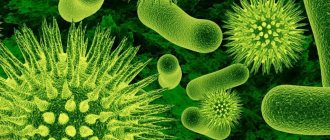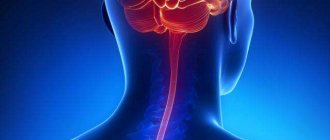Meningoencephalitis viral, bacterial, parasitic
The term “meningoencephalitis” includes two nosological forms: “encephalitis” and “meningitis”.
The definition describes the morphological changes that occur against the background of pathology - damage to the white matter and meninges. The pathology is characterized by high mortality, disability, and a large number of disorders. Diagnosis of the symptoms of the disease at the beginning of its development, prevent dangerous consequences, eliminate damage to functional centers. The effectiveness of treatment depends on the cause, pathogen, and extent of the inflammatory focus.
The initial signs of pathology are neurological disorders. Neurologists conduct differential diagnostics that allow one to suspect meningoencephalitis and timely prescribe neuroimaging methods (brain MRI and CT).
Pathogenesis
When the pathogen penetrates the brain tissue, inflammation begins in them. It can be purulent or serous, which depends on the type of infectious agent. Subsequently, the following processes occur in the body:
- Infiltrates form around the blood vessels - accumulations of cellular elements in the tissues with admixtures of blood and lymph.
- Perivascular (localized around blood vessels) inflammatory infiltrates disrupt cerebral circulation.
- Foci of ischemia (necrosis of tissues that have been deprived of blood supply) appear in the brain, acting as a secondary damaging factor.
- The body reacts to this condition by increasing the production of cerebrospinal fluid (CSF), which circulates in the ventricles of the brain.
- Excess cerebrospinal fluid leads to the development of intracranial hypertension.
- The combination of these pathological processes causes irritation of the meninges - meningeal syndrome.
- As a result of the death of neurons, focal symptoms develop, which manifest themselves as neurological deficits. It causes insufficient mobility of the limbs, changes in the sensitive, emotional and intellectual spheres.
Meningoencephalitis - what is it?
There are congenital and acquired forms. Meningoencephalitis in children occurs due to intrauterine infection (cytomegalovirus, chlamydia, meningococcal). Immediately after birth, it is difficult to identify the nosology, since the child cannot talk about sensations.
In the first month of life, the first signs appear. Only the acute variety is accompanied by multiple changes, which often lead to death. Analysis of cerebrospinal fluid helps to suspect inflammation of the brain and membranes at the beginning of development.
The procedure is invasive and is prescribed according to strict indications. The harmlessness of MRI for meningoencephalitis makes it possible to prescribe examinations for newborns and infants. The high cost of equipment excludes the possibility of installing devices everywhere.
The main causes of mortality from inflammatory processes of the soft membrane and brain parenchyma:
- Intracerebral edema;
- Infectious shock;
- Cerebral hypertension;
- Kidney failure.
The consequences of the disease in subacute and chronic forms develop over several years.
MRI meningoencephalitis
Diagnostics
At the first stage of diagnosis, the doctor interviews the patient and his relatives to collect anamnesis in order to identify traumatic brain injuries, infections, facts of vaccination, and tick bites. Next, in order to identify characteristic meningeal symptoms, the patient is examined by a neurologist: assesses the state of consciousness, detects a neurological deficit. These signs indicate an inflammatory process in the medulla and membranes. Then the doctor prescribes the following laboratory tests:
- Blood analysis. An increased level of leukocytes and an acceleration of the erythrocyte sedimentation rate indicate the presence of an inflammatory process in the body.
- PCR. This is a polymerase chain reaction method, which is aimed at identifying the DNA of the pathogen in the body. This analysis allows you to accurately determine the type of infectious agent.
- Blood culture for sterility. This test is carried out to identify bacteria. The analysis is indicated for suspected sepsis. A blood sample is taken from a peripheral vein using a sterile syringe.
It is important to differentiate meningeal signs from other diseases: brain tumors, toxic lesions of the nervous system, major strokes and degenerative processes. The following instrumental studies help to definitively confirm the diagnosis:
- Computed and magnetic resonance imaging (CT and MRI). These procedures help detect changes in the brain: diffuse tissue changes, thickening, compaction of the meninges. Infection by parasitic agents is confirmed by identifying rounded lesions with ring-shaped enhancement along the periphery.
- Lumbar puncture. This study definitively determines the type of pathogen. The essence of the procedure is the collection and examination of cerebrospinal fluid (CSF). In a purulent process, it becomes cloudy and acquires a flocculent sediment; in a hemorrhagic process, it contains elements of blood; in a serous process, it is transparent.
- Stereotactic brain biopsy. This is a neurosurgical operation of a diagnostic nature. It is carried out in more severe cases to exclude tumor processes.
ICD 10 code for meningoencephalitis
The international classification of the tenth revision identifies the following types of brain inflammation with code “G04”:
- Meningomyelitis;
- Meningoencephalitis;
- Acute ascending myelitis.
The category excludes multiple sclerosis (“G95”), toxic, alcoholic encephalopathy “G31.2”, “G92”.
Classification of meningoecephalitis by course:
- Chronic – long-term development with a slow increase in symptoms;
- Subacute - erased signs of nosology increase over two to three years;
- Acute – rapid progression of symptoms helps early diagnosis;
- Fulminant – rapid cerebral damage causes death.
The difficulties of verifying pathology are complicated by the variety of etiological factors.
Causes of meningoencephalitis
Viral forms provoke chronic and subacute varieties. An acute course can be observed in people with immunodeficiencies. Pathogenic bacteria quickly destroy the arachnoid, subarachnoid membranes, and brain parenchyma. Parasitic (amebic) species progress slowly.
Features of influenza hemorrhagic meningoencephalitis
Nosology is a consequence of influenza. An acute respiratory viral infection provokes a rise in temperature and enlargement of the pharyngeal tonsils. Long-term persistence of infection causes epileptic convulsions.
Fever increases brain destruction, but no antiviral treatment has been developed. Vaccination and strengthening the immune system are the main measures to counter the spread of influenza hemorrhagic infection.
Principles for diagnosing viral meningoencephalitis:
- Absence of bacteria in brain preparations when stained by Gram;
- Cerebrospinal fluid pleocytosis;
- Detection of enteroviruses, arboviruses, herpesviruses using polymerase chain reaction (PCR).
Severe and fatal cases are caused by enteroviruses. Over serotypes of pathogens have been identified, causing a variety of clinical manifestations of the disease. Enteroviral neuroinfection often leads to death and disability.
After a bite from ticks, insects, or mosquitoes, the inflammatory process of cerebral tissues is caused by arboviruses if the carrier was infected with microbes. In addition to humans, these pathogens infect horses and dogs, which can also be a source of infection for humans.
Common encephalitis caused by arboviruses:
- West Nile fever;
- Encephalitis St. Louis;
- California uniform.
The prevalence of diseases has been increasing in recent years.
Symptoms of herpetic encephalitis
Activation of herpetic neuroinfection is the cause of death in approximately seventy percent of adults and children. The lack of antiherpetic therapy excludes the possibility of effective treatment. Only a strong immune system can cope with the herpes virus. The weak body of a pregnant woman in the presence of infection becomes a source of infection of the fetus in utero.
Herpes simplex virus type 2 (HSV-2) becomes the source of a mild transient type of neuroinfection. Meningoencephalitis is activated in adolescents with an active sexual life.
In newborns, herpes simplex virus type 1 or 2 is part of the associated infections. A generalized disease affecting many organs is caused by HSV in patients with immunodeficiencies, including AIDS. The lack of pharmaceuticals causes the death of 2/3 of infants.
The first signs of herpesvirus neuroinfection:
- High fever;
- Strong headache;
- Behavioral disorders;
- General cerebral symptoms.
The drug virolex (acyclovir) increases your chances of survival. In severe cases, the drug is ineffective.
Rare forms of viral encephalitis
Damage to the central nervous system is caused by the varicella zoster virus, which occurs after an illness. Nosology has symptoms:
- Cerebellar ataxia – incoordination of muscle activity, unsteady gait;
- Acute encephalitis.
Acute manifestations are rare. The chickenpox virus is characterized by a chronic course with cycles of remissions and exacerbations, since the pathogen persists in the nerve ganglia. Reactivation of chickenpox is possible with a decrease in immunity.
Rare types of viral meningoencephalitis:
- Cytomegalovirus - destroys cerebral tissue only in immunodeficiencies;
- Mumps – caused by the mumps virus. It is characterized by a mild course, but causes inflammation of the auditory nerve.
The lack of a complete diagnosis excludes the possibility of early detection of neuroinfection.
Clinic of bacterial meningoencephalitis
Pathogenic bacteria enter the brain through the blood and lymphatic fluid. The penetration of microorganisms from the primary focus of internal organs is dangerous due to the resistance of the agents to the antibiotics used to eliminate the disease.
Types of bacterial meningoencephalitis:
- Brucellosis;
- Toxoplasmosis;
- Syphilitic;
- Tuberculous;
- Meningococcal.
Signs are determined by the type of etiological factor. Damage to cerebral tissue appears against the background of a primary infection of internal organs. Congenital types arise due to the entry of microorganisms into the fetus during childbirth.
Tuberculous encephalitis develops in people with primary tuberculosis of different localization. The peak of infection occurs in the spring-autumn period, when immune activity is reduced. The nosology has no specific manifestations. Diagnosed by laboratory, clinical and instrumental methods.
Mycobacterial infection is difficult to treat. Of the bacterial species, nosology is the most dangerous. Main clinical signs of pathology:
- Poor concentration;
- Strong headache;
- General cerebral disorders;
- Photophobia;
- Vegetative manifestations;
- Neurological disorders;
- Hydrocephalus.
Acute manifestations of the disease are characterized by an increase in temperature to thirty-nine degrees. Clinical manifestations of the disease are accompanied by fever, joint pain, sleep disturbance, abnormal meningeal signs, and fever. The average duration of the disease is about ten days. Associated signs of nosology are lack of appetite, excessive sweating, cerebellar disorders, mobility impairment, positive Rehberg test. (a person cannot touch the tip of his nose with his index finger).
The temperature curve against the background of inflammatory changes in the cerebral parenchyma and meninges has a specific course. Initially, the fever increases to 39 degrees. After 5-7 days, the fever subsides to low-grade levels (38.5 degrees). A second wave is observed on the tenth day. Focal neurological symptoms appear with neuritis, radiculitis, changes in the activity of the heart, pulmonary system, dizziness, convulsions, paresthesia (lack of sensitivity).
The brucellosis species provokes pyramidal symptoms with paresis, paralysis, and muscle cramps.
Characteristics of parasitic meningoencephalitis
Amoebas are found in young children and newborns. The parasites cause inflammation of the brain with a high mortality rate.
Pathogens enter through the upper respiratory tract. The source of infection is reservoirs, tap water, contaminated vegetables and fruits.
Clinical manifestations of amoebic encephalitis, meningitis:
- Granulomatous inflammation of the white matter takes several months to form. Damage to the membranes clinically resembles a volumetric intracerebral formation with the formation of several centers of activity - convulsions, personality disorders, paralysis, paresis;
- Acute variety - lasts two weeks. It begins with lightning speed, accompanied by nausea, headaches, and a significant increase in temperature. Multiple foci cause death in infants and children.
Early detection and proper drug therapy eliminate the risk of serious complications.
Classification
Neurology divides meningoencephalitis according to the type of etiology, the nature of the changes caused, and the type of development. Confirmation of the type of disease occurs at the diagnostic stage, which is a central factor in choosing treatment tactics.
Etiological types of disease:
- Viral—the source includes herpes simplex, influenza, measles, rabies, cytomegalovirus, and enterovirus viruses. It has a serous type of inflammatory consequences.
- Bacterial - has a purulent inflammatory nature caused by pneumo-, strepto-, meningococci, Haemophilus influenzae, Klebsiella.
- Protozoan—a rare species caused by protozoa (amoeba, toxoplasma).
- Fungal—diagnosed mainly in individuals with secondary immune deficiency. Often accompanies the development of neuroAIDS.
According to the type of inflammatory course, meningoencephalitis is divided into:
- Serous - characterized by the formation of serous discharge. Blood lymphocytosis is typical. The cerebrospinal fluid is clear.
- Purulent—pus forms, which causes clouding of the cerebrospinal fluid. Leukocytosis is noted.
- Hemorrhagic—multiple petechial hemorrhages occur in the brain tissue, caused by impaired permeability of the vascular walls.
By type of clinical course:
- Lightning—forms within a matter of hours, in most cases ending in the death of the patient.
- Acute—develops from 1 to 2 days, the clinical picture worsens more slowly than with the fulminant form.
- Subacute—occurs in stages, symptoms worsen over several days, but not more than a week.
- Chronic—inflammation develops over several months with periods of remissions and exacerbations. Acute and subacute forms can become chronic.
Characteristics of autoimmune encephalitis
The formation of antibodies to brain tissue causes demyelination. The process is long but progressive. Rasmussen's encephalomyelitis is a typical manifestation of an autoimmune lesion of the cerebral parenchyma. Depending on the characteristics of the development of the process, the duration is from five to fifteen years. In most cases, the clinical peak occurs at six years of age.
Nosology has been thoroughly studied by scientists. The causes of the occurrence could not be established, but the link to which immunoglobulins are formed was identified. The presence of NMDA receptors is a weak point that is susceptible to destruction by the immune system.
There are case studies showing the nonspecificity of glutamate receptor antibodies for Rasmussen's encephalomyelitis. Other anti-inflammatory cytokines formed during the nosology have been identified.
Routes of infection
The main reason for the development of meningoencephalitis is the penetration of an infectious agent into the membranes and substance of the brain. The pathogen can spread throughout the body through the blood or lymph. The method of infection is determined by its type. Depending on the type of pathogen, infection with meningoencephalitis can occur in the following ways:
- when bitten by an ixodid tick, which is a carrier of a neurotropic virus;
- airborne (this is how meningococcal infection is transmitted, affecting mainly children);
- as a result of penetration into the nasopharynx of mutant amoebae naegleria fowleri from a polluted reservoir;
- by direct contact in case of breakthrough of pus cavities or violation of the integrity of the skull bones;
- vertical (infection occurs when the child passes through the mother’s birth canal or in utero at the beginning of the gestational period).
Meningoencephalitis of newborns
The most common pathogen is viruses. Intrauterine infection of a baby occurs from a mother suffering from glandular fever, measles, rubella, herpetic infection, and mumps.
The most common symptoms are focal disorders, hyperkinesis, hydrocephalus. Nonspecific manifestations of meningoencephalitis in newborns:
- Eye twitching;
- Difficulty feeding from the breast;
- High fever;
- Intoxication syndrome;
- Vomiting reflex;
- Diarrhea;
- Strabismus;
- Increased heart rate (tachycardia);
- Muscle twitching.
Neurologists define neurological disorders in the form of Kernig's sign (the inability to bring the head to the chest due to stiff neck muscles). Cerebrospinal fluid contains an increased amount of lymphocytes and protein.
Treatment with folk remedies
Under no circumstances should meningoencephalitis be treated at home without medical supervision. This is fraught with serious complications and death. Therefore, any traditional methods can be used exclusively to alleviate the patient’s condition and only after approval by a doctor.
It is recommended to use infusions and decoctions of medicinal herbs:
- Lavender officinalis. This remedy has a diuretic, sedative and anticonvulsant effect. To prepare the infusion, 3 tsp. Lavender flowers need to be poured with 2 cups of boiling water and left for half an hour.
- Chamomile officinalis. Soothes and relieves pain. Used in the form of tea, for the preparation of which 1 tbsp. l. pour 1 cup of boiling water over the flowers and leave for 15 minutes.
- Peppermint. Anticonvulsant, anti-inflammatory and diuretic. To prepare 1 tbsp. l. mint leaves are poured with 1 cup of boiling water and left for 15 minutes.
- Cranberry juice. It is prepared for patients who suffer from fever. This drink contains a lot of vitamin C , and it also has an antimicrobial effect.
- Rosehip decoction. For loss of strength, headaches, and also to increase the body's resistance, a decoction is effective, which is prepared by pouring 1 tbsp. l. rose hips with a glass of boiling water. After boiling for 10 minutes, leave the product for another half hour and drink half a glass three times a day.
- Collection of herbs for headaches. For severe headaches, you can use a collection of the following medicinal plants: primrose root, peppermint leaves, lavender flowers, valerian root, rosemary leaves. You need to take 5 g of each herb, pour 200 ml of boiling water over the mixture, leave and drink 1 tbsp. 3 times a day.
- Lime tea. It helps relieve pain and acts as an anti-inflammatory agent. 1 tbsp. l. linden blossom should be poured with a glass of boiling water, steeped and taken as tea.
- Extract for compresses. Mix 20 g of peppermint leaves, lemon balm, and coriander fruits. Pour in 100 ml of alcohol and 20 ml of water. After 24 hours, you can soak gauze in the product and apply it to your temples and the back of your head if you have a headache.
- Baths . After removing the acute symptoms of the disease, you can periodically take baths to help calm the nervous system. To prepare such baths, pine needle extract and chamomile decoction are used.
Manifestations of meningoencephalitis in adults
Various symptoms of the disease in an adult are caused by different pathogens and characteristics of the course. The incubation period of the disease lasts several weeks.
Symptoms of the clinical stage:
- Muscle stagnation;
- Decreased appetite;
- Constant fatigue;
- Headaches without the effectiveness of painkillers.
Inflammatory changes in the meninges lead to meningeal syndrome with special manifestations:
- Nausea;
- Speech disorders;
- Interruptions of heart activity;
- Respiratory disorders.
The occurrence of the described manifestations leads to death. The progression of individual symptoms becomes a cause of disability.
Clinical picture of the disease
The clinical picture of meningoencephalitis combines general infectious, meningeal, liquor-hypertensive, and focal symptoms. Infectious manifestations include high body temperature, a general painful condition, decreased appetite, and sometimes skin rashes. Against the background of an ongoing infection, signs of brain damage appear.
Increased pressure in the cerebrospinal fluid causes severe headache, nausea, and vomiting, which does not provide relief. Increasing intracranial pressure leads to a disorder of consciousness with disorientation, mental agitation or, on the contrary, retardation. In the fulminant form, the patient often falls into a coma.
Focal neurological failure depends on the location and type of inflammation and is expressed to varying degrees. Manifests itself in the form of hemiparesis, sensorimotor aphasia, hyperkinesis, cerebellar syndrome, vestibular ataxia, and cognitive impairment. Oculomotor and visual disorders, ptosis, facial distortion, swallowing disorders, and dysarthria are the result of damage to the cranial nerves.
Consequences of meningoencephalitis
In addition to high mortality, the disease is characterized by dangerous conditions leading to disability. Severe consequences of inflammation of the white matter and meninges:
- Paralysis of limbs;
- Epileptic seizures;
- Mental retardation in children;
- Hydrocephalus;
- Psychoses;
- Hallucinosis.
The conditions are irreversible. Early verification and competent therapy prevent negative consequences in bacterial types of encephalitis and meningitis. For other forms of nosology, the prognosis is unfavorable.
Diagnosis of inflammation of the brain and soft membranes
The most accurate laboratory method for verifying nosology at the beginning of development is cerebrospinal fluid analysis. Turbidity in the cerebrospinal fluid that bathes the brain and spinal cord indicates the presence of infection. Determination of additional impurities, accumulations of leukocytes and lymphocytes indicates a bacterial infection. With pathology, an increase in the content of glucose and protein occurs.
Clinical and instrumental methods for examining the cerebral parenchyma - radiography, CT, MRI, electroencephalography (EEG). Neuroimaging determines the spread of inflammation, the depth of the lesion, and concomitant pathology.










